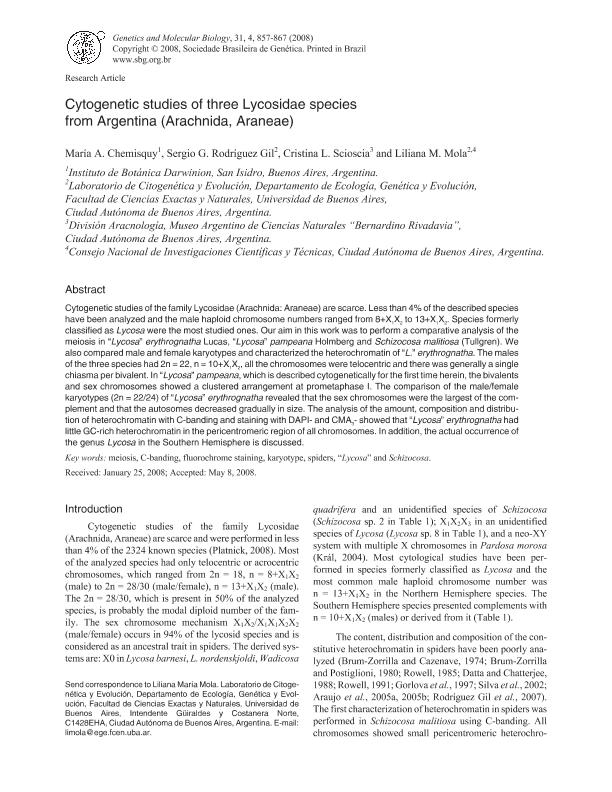Artículo
Cytogenetic studies of three Lycosidae species from Argentina (Arachnida, Araneae)
Chemisquy, Maria Amelia ; Rodríguez Gil, Sergio Gustavo
; Rodríguez Gil, Sergio Gustavo ; Scioscia, Cristina Luisa
; Scioscia, Cristina Luisa ; Mola, Liliana Maria
; Mola, Liliana Maria
 ; Rodríguez Gil, Sergio Gustavo
; Rodríguez Gil, Sergio Gustavo ; Scioscia, Cristina Luisa
; Scioscia, Cristina Luisa ; Mola, Liliana Maria
; Mola, Liliana Maria
Fecha de publicación:
12/2008
Editorial:
Sociedade Brasileira de Genética
Revista:
Genetics and Molecular Biology
ISSN:
1415-4757
e-ISSN:
1678-4685
Idioma:
Inglés
Tipo de recurso:
Artículo publicado
Clasificación temática:
Resumen
Cytogenetic studies of the family Lycosidae (Arachnida: Araneae) are scarce. Less than 4% of the described species have been analyzed and the male haploid chromosome numbers ranged from 8+X1X2 to 13+X1X2. Species formerly classified as Lycosa were the most studied ones. Our aim in this work was to perform a comparative analysis of the meiosis in "Lycosa" erythrognatha Lucas, "Lycosa" pampeana Holmberg and Schizocosa malitiosa (Tullgren). We also compared male and female karyotypes and characterized the heterochromatin of "L." erythrognatha. The males of the three species had 2n = 22, n = 10+X1X2, all the chromosomes were telocentric and there was generally a single chiasma per bivalent. In "Lycosa" pampeana, which is described cytogenetically for the first time herein, the bivalents and sex chromosomes showed a clustered arrangement at prometaphase I. The comparison of the male/female karyotypes (2n = 22/ 24) of "Lycosa" erythrognatha revealed that the sex chromosomes were the largest of the complement and that the autosomes decreased gradually in size. The analysis of the amount, composition and distribution of heterochromatin with C-banding and staining with DAPI- and CMA3- showed that "Lycosa" erythrognatha had little GC-rich heterochromatin in the pericentromeric region of all chromosomes. In addition, the actual occurrence of the genus Lycosa in the Southern Hemisphere is discussed.
Archivos asociados
Licencia
Identificadores
Colecciones
Articulos(IEGEBA)
Articulos de INSTITUTO DE ECOLOGIA, GENETICA Y EVOLUCION DE BS. AS
Articulos de INSTITUTO DE ECOLOGIA, GENETICA Y EVOLUCION DE BS. AS
Articulos(MACNBR)
Articulos de MUSEO ARG.DE CS.NAT "BERNARDINO RIVADAVIA"
Articulos de MUSEO ARG.DE CS.NAT "BERNARDINO RIVADAVIA"
Citación
Chemisquy, Maria Amelia; Rodríguez Gil, Sergio Gustavo; Scioscia, Cristina Luisa; Mola, Liliana Maria; Cytogenetic studies of three Lycosidae species from Argentina (Arachnida, Araneae); Sociedade Brasileira de Genética; Genetics and Molecular Biology; 31; 4; 12-2008; 857-867
Compartir
Altmétricas



